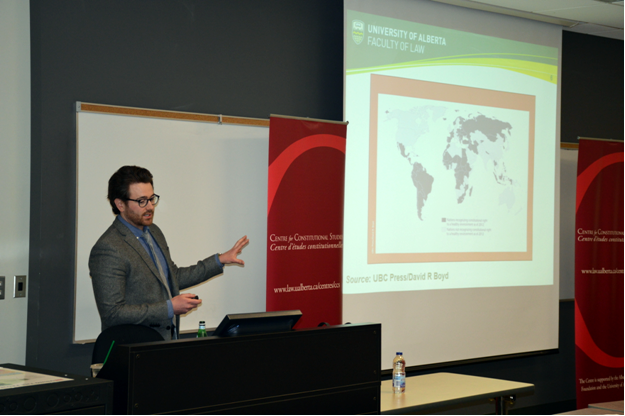
The oft-used cliché about not seeing the forest for the trees is nowhere more apt than it is here in Canada. In an age of vanishing wildlands and depleted resources, Canada can rightfully claim to be a (relative) bastion of ecological health, being home to nearly ten per cent of the world's forest cover, 20 per cent of its fresh water, and 25 per cent of its wetlands, and being generally synonymous worldwide with unspoiled wilderness.
Look closer, however, and the picture is far less bucolic, with Canada routinely ranked near the bottom among industrialized nations for environmental protection by the international community. It also has the dubious distinction of being a notable holdout (together with fellow laggards Australia and the United States) from the growing international movement to expand constitutional rights to include environmental protection.
The question of whether or not Canada should explicitly incorporate the environment into its Charter of Rights and Freedoms was the subject of Dr. Cameron Jefferies' March 22 lecture "If It's Easy Being Green, How Come Our Charter Isn't?", the latest installment of the Centre for Constitutional Studies' Downtown Charter Series-and coinciding, fittingly, with World Water Day.
"It's never been quite clear where the environment fits in the Canadian Constitution or in the Charter of Rights and Freedoms," Jefferies explains.
"Of course there are many parts of the Charter that deal either directly or indirectly with the environment, notably in Section 7, wherein the guarantee to life, liberty, and the security of the person is spelled out, but nowhere in the constitution are environmental issues explicitly addressed."
Jefferies asserts that a strong case exists for enshrining environmental protection within the Charter. Such inclusion, he argues, would result in stronger environmental laws, a "safety net" that would plug legislative gaps, provide safeguards against government rollbacks to environmental laws, and greater protection for communities disproportionately impacted by environmental degradation-most notably indigenous communities.
Commonly proffered counterarguments to such constitutional amendments, he contends, range from easily countered worries about negative economic impacts and excessive judicial power to legitimate definitional concerns, namely the fact that the term "healthy environment" is difficult if not impossible to define. He also concedes that many of the countries that theoretically guarantee a healthy environment are in reality ecological disasters (notably Russia) while some of the world's greenest countries, such as Sweden, New Zealand, and Uruguay, have no such constitutional safeguards.
Nevertheless, Jefferies cites a growing body of evidence that constitutional guarantees of a healthy environment are doing legal heavy lifting the world over, both in the developed world and in poorer countries such as the Philippines, where such constitutional leverage was used to great effect to force the government to take action to clean up Manila's notoriously polluted bay.
He contrasts this to Canada, where, as of the end of 2016, there were 127 water quality advisories in effect in First Nations, some of which have been in place for years.
"We like to think it's easy being green, but it's not," he concludes.
"Making the drastic decision to really make progress on the environment is going to require a lot more than carpooling, recycling, and other things we do as individuals. We're really going to have to do the hard stuff, and that requires political will. Greening the constitution isn't the only way of doing it, but I truly believe it would be a step in the right direction."